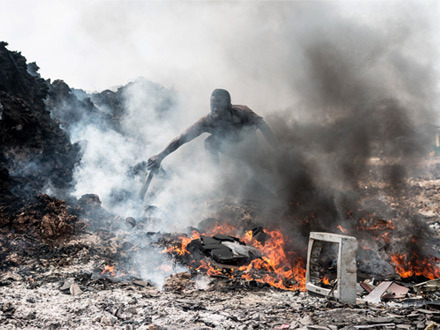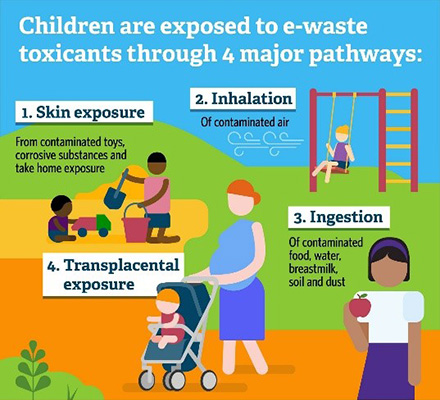By Brenda Onyango

The World Health Organization (WHO) report, Children and digital dumpsites: E-waste exposure and child health , details the effects of what Tedros Adhanom Ghebreyesus, Ph.D., the WHO director-general, calls a "mounting ‘tsunami of e-waste'" on children's and women's health. According to the report, in 2019 alone, roughly 53.6 million tons of electrical waste or e-waste was produced worldwide, and e-waste is projected to grow to 74.7 million tons by 2030. The groundbreaking report provides a comprehensive overview of the pathways of e-waste exposure, associated health effects, and the way forward for health and policy sectors around the globe to respond to e-waste and recycling practices.
A global public health threat, e-waste includes phones, computers, tablets, televisions, and other electrical devices that have been discarded. Though e-waste is generated in multiple regions around the world, countries like the United States, Brazil, United Kingdom, Russia, India, and China are heavy producers given consumer trends in purchasing electronics, design practices that decrease the lifespan of devices, and other factors.
Much of the world's e-waste ends up in Africa, Asia, and Latin America where residents, often children and women, informally recycle e-waste for valuable materials like gold, copper, silver, cobalt, platinum, iron, aluminum, and more.
Occupational and Community Exposure to E-waste
Expansive, informal e-waste sites like Agbogbloshie in Accra, Ghana or Guiyu in Guangdong Province, China are work sites for many people. Because e-waste is pervasive in the waste streams of low- and middle-income countries, workers in the informal waste management sector may have increased exposure to e-waste and its hazards. Estimates from the World Bank and the International Labor Organization put the number of informal waste workers between 15-20 million people. The WHO estimates that 2.9-12.9 million women, including a significant number of childbearing age, work in the informal waste sector. Over 18 million children ages 5-17 work in the industrial sector, of which e-waste management is a growing segment.
E-waste exposure occurs at major recycling sites and in home-based family workshops. Contaminants from e-waste have been found in the floors, water, soil, and air in communities where recycling takes place and even in areas distant from recycling sites since contaminants can be transported long distances by air, water, soil, and food contamination, and on the clothes of workers.
The Pathways and Health Effects of E-waste Exposure for Children
There are multiple pathways of exposure to e-waste contaminants, but the new report draws special attention to pathways that affect children, even before they are born. Expectant mothers who work or live near e-waste sites can be exposed to toxicants, which results in exposures to their fetus. Researchers are working to understand the effects of in utero exposure on development.

Figure illustrating the major physiological pathways of children’s exposure of hazardous e-waste substances.
(Photo courtesy of World Health Organization)
Infants can be exposed to toxicants via contaminated food, water, breastmilk, soil, and dust. Dermal exposure poses unique concerns for infants since the skin barrier may not fully develop until a child is two years old. Growing children breathe more air and consume more food and water relative to their size than adults and are less able to break down and eliminate some hazardous substances. Additionally, young children spend time near the ground playing and have developmentally appropriate hand-to-mouth and object-to-mouth behaviors that lead to inhalation and ingestion of contaminated dust or soil. Many of the pathways of exposure apply to children that work in the informal e-waste recycling center.
Unaltered e-waste can include lead, chromium, cadmium, mercury, and other chemicals. According to the WHO, these substances have the following health effects:
- Lead is known to have neurodevelopmental, renal, cardiovascular, and reproductive health effects.
- Chromium is a carcinogen and allergen.
- Cadmium and mercury can both affect renal health.
Altering e-waste can involve open burning, heating, and acid leaching to separate the desired metals, such as copper, from other parts of the waste. When e-waste is altered by physical and chemical means, more toxicants can be produced, including persistent organic pollutants, polycyclic aromatic hydrocarbons, flame retardants, and other classes of toxicants.
The WHO's 10 Chemicals of Public Health Concern
Chemicals in italics can be found in e-waste or created in the recycling process.
- Air pollution
- Arsenic
- Asbestos
- Benzene
- Cadmium
- Dioxins and dioxin-like substances
- Highly hazardous pesticides
- Inadequate or excess fluoride
- Lead
- Mercury
The WHO has identified 10 chemicals of public health concern , and many chemicals found in e-waste or produced by recycling processes are on this list.
Public Health and Policy Measures to Reduce E-waste Exposure
The WHO report presents actions that global, national, and local public health and policy sectors can take to improve health and safety for e-waste workers and communities impacted by the industry. In terms of upstream opportunities, industries can improve product design and consumers can help reduce generation of e-waste.
Actions to address health and safety issues related to e-waste management include monitoring exposure and health outcomes and promoting safer collection and treatment of e-waste. There is also a global need to build the capacity of primary health care to diagnose and respond to toxic exposure from e-waste contaminants among children and women.
NIEHS Activities Related to E-waste and Children's Health
E-waste is a major topic of concern at NIEHS, and multiple collaborative efforts to identify the scale of and solutions to the e-waste problem are ongoing.
NIEHS grantees and researchers funded by the NIH Fogarty International Center (FIC) have previously collaborated with the Vietnam National Institute of Occupational and Environmental Health to monitor lead levels among children living near home-based recycling activities in pre- and post-intervention periods. The interventions, led by the Vietnam Environment Administration and local NGOs, helped to reduce contaminants in homes and schools.
FIC - in collaboration with NIEHS, the National Institute for Occupational Safety and Health, the National Cancer Institute, and Canada's International Development Research Centre - launched an environmental and occupational health hub based in Ghana. As part of the mission to build research capacity, the hub has included early-stage researchers in their field research on the health effects of e-waste recycling at the Agbogbloshie site in Accra, Ghana.
NIEHS has been a designated WHO Collaborating Centre (WHO CC) for Environmental Health Sciences since 2013. This key partnership has created opportunities to build capacity in this area, including several webinars, sessions at national and international conferences, commentaries, reviews, and a podcast episode on e-waste.
"This report highlights an important problem that is gaining more worldwide attention," said Brittany Trottier, M.P.H., health specialist in the Superfund Research Program and technical reviewer for the WHO report. "E-waste is a focus area of the NIEHS WHO CC, so in that capacity, we have facilitated several activities aimed at making the scientific community aware of the potential health problems associated with informal recycling practices. This work serves as a call for the scientific community to come together to offer sustainable solutions for the women and children at highest risk of health effects arising from recycling practices."

